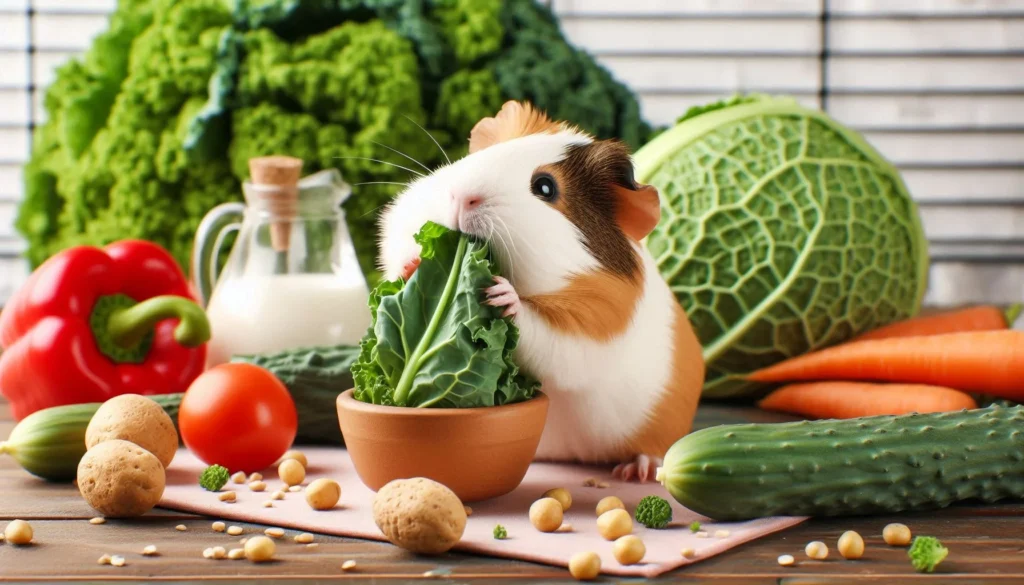Guinea pigs are adorable, social, and herbivorous pets that rely on a balanced diet to stay healthy. While hay should make up the majority of their diet, fresh vegetables like leafy greens play a crucial role in providing essential vitamins and minerals. One such green is collard greens, but can guinea pigs eat them safely? In this comprehensive guide, we’ll explore everything you need to know about feeding collard greens to your guinea pig, including their nutritional benefits, potential risks, and how to serve them properly.
Can Guinea Pigs Eat Collard Greens?
Yes, guinea pigs can eat collard greens, but in moderation. Collard greens are a nutritious leafy green that can be a healthy addition to your guinea pig’s diet. However, like many vegetables, they should not be overfed due to their high calcium content, which can lead to health issues like bladder stones.
Guinea pigs thrive on variety, so collard greens should be part of a rotating menu of safe vegetables. This ensures your pet gets a wide range of nutrients without overloading on any single type of food.
Nutritional Information for Collard Greens
Collard greens are packed with essential nutrients that can benefit your guinea pig’s health. Here’s a breakdown of their nutritional profile:
| Nutrient | Amount per 100g | Benefits for Guinea Pigs |
|---|---|---|
| Vitamin C | 35.3 mg | Boosts immune system, prevents scurvy |
| Calcium | 232 mg | Supports bone health |
| Fiber | 4 g | Aids digestion, prevents bloating |
| Vitamin K | 510 µg | Promotes blood clotting |
| Vitamin A | 5019 IU | Supports vision and skin health |
| Antioxidants | High | Fights free radicals, reduces inflammation |
Key Nutrients Explained:
- Vitamin C: Guinea pigs cannot produce their own Vitamin C, so they need it from their diet. Collard greens are a good source, but they should not be the sole provider.
- Calcium: While calcium is essential for strong bones, too much can lead to bladder stones in guinea pigs. This is why moderation is key.
- Fiber: Guinea pigs need a high-fiber diet to maintain healthy digestion. Collard greens contribute to this, but hay should remain the primary fiber source.
Benefits of Collard Greens for Guinea Pigs
Collard greens offer several health benefits for guinea pigs when fed correctly:
- Immune Support: The high Vitamin C content helps prevent scurvy, a common health issue in guinea pigs.
- Digestive Health: The fiber in collard greens aids in digestion and prevents gastrointestinal problems.
- Bone Health: Calcium supports strong bones and teeth, though it must be balanced with other low-calcium foods.
- Antioxidants: These help reduce inflammation and support overall health.
Risks of Feeding Collard Greens to Guinea Pigs
While collard greens are nutritious, there are some risks to be aware of:
- High Calcium Content: Excessive calcium can lead to bladder stones, which are painful and require veterinary care.
- Oxalates: Collard greens contain oxalates, which can contribute to kidney stones if fed in large quantities.
- Gas and Bloating: Overfeeding can cause digestive discomfort, including gas and bloating.
To minimize these risks, collard greens should be fed in moderation and rotated with other low-calcium vegetables.
How to Safely Feed Collard Greens to Guinea Pigs
Here’s a step-by-step guide to safely introducing collard greens into your guinea pig’s diet:
- Serving Size: Offer 1-2 leaves of collard greens, 2-3 times per week. This ensures your guinea pig gets the benefits without overloading on calcium.
- Preparation: Wash the leaves thoroughly to remove pesticides, dirt, and bacteria.
- Introduction: Start with a small piece to see how your guinea pig reacts. Gradually increase the amount if there are no digestive issues.
- Rotation: Combine collard greens with other safe vegetables like romaine lettuce, bell peppers, and cilantro for a balanced diet.
Alternatives to Collard Greens
If you’re looking to diversify your guinea pig’s diet, here are some safe alternatives to collard greens:
- Romaine Lettuce: Low in calcium and high in water content.
- Bell Peppers: Rich in Vitamin C and low in calcium.
- Cilantro: A flavorful herb that’s safe in moderation.
- Kale: High in nutrients but should be fed sparingly due to calcium content.
Pro Tip: Rotate these vegetables to provide a variety of nutrients and prevent boredom.
Conclusion
Collard greens can be a healthy and nutritious addition to your guinea pig’s diet when fed in moderation. They provide essential vitamins like Vitamin C and fiber, but their high calcium content means they should not be overfed. By following the guidelines in this article, you can safely incorporate collard greens into your guinea pig’s diet while minimizing risks.
Remember, a balanced diet for your guinea pig should include a variety of vegetables, plenty of hay, and fresh water. If you have any concerns about your guinea pig’s diet, consult a veterinarian for personalized advice.
So, go ahead and treat your furry friend to some collard greens—just remember, moderation is key! 🥬🐹
Frequently Asked Questions (FAQs)
Can Baby Guinea Pigs Eat Collard Greens?
Yes, but in very small amounts. Baby guinea pigs have sensitive digestive systems, so introduce collard greens gradually and monitor for any adverse reactions.
How Often Can Guinea Pigs Eat Collard Greens?
Feed collard greens 2-3 times per week in small quantities. This ensures they get the benefits without the risks of overfeeding.
What Are the Signs of Overfeeding Collard Greens?
Watch for symptoms like bloating, gas, or changes in urine (e.g., cloudy or bloody urine, which may indicate bladder stones).
Are Collard Greens Better Than Other Leafy Greens?
Collard greens are nutritious but should not replace other leafy greens. A varied diet is key to meeting all your guinea pig’s nutritional needs.

